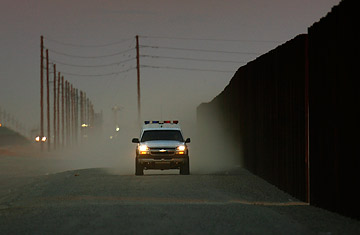
A border patrol vehicle drives along a wall of metal that runs along the U.S.-Mexico border east of San Luis, California.
Perhaps no one told Homeland Security Secretary Michael Chertoff, even though he works in the Bush White House, that you don't mess with Texas. Why else would he be pushing so hard to build a border fence that folks in the Lone Star State don't want, so much so that a group of South Texas leaders have now hauled him into court?
The Texas Border Coalition, which includes just about every mayor and local Chamber of Commerce in the 1,200-mile Rio Grande Valley, accuses Chertoff of seizing land to build the fence without first negotiating a fair price. TBC's complaint, filed in federal district court in Washington, D.C., also alleges that the Department of Homeland Security may be favoring wealthy landowners by routing the fence away from their property. "I puzzled a while over why the fence would bypass the industrial park and go through the city park," Eagle Pass Mayor Chad Foster, the coalition chairman, says in the suit.
Elsewhere along the border between the U.S. and Mexico, National Guard teams and private contractors have built more than 300 miles of new fencing in the past year with little official complaint from local citizens. Along big stretches of the Arizona border, for example, the fence crosses uninhabited desert lands already owned by the federal government.
But plans to fence 70 miles of the Texas border — mainly the populated stretches, where immigrants and smugglers can reach safe-houses or catch a ride north within minutes of crossing — have stirred up serious opposition. South Texans are happy with the soft barrier provided by nature — the Rio Grande — and enjoy a long history of easy commerce from one side of the border to the other and back again. In other words, Tex-Mex is more than a style of cooking down there — it's an entire culture, and what looks like a bright line on the map is actually an indefinite blend of one nation into another.
Compounding the problem is that there is no simple way to run a fence through these towns. In some places, families own property that actually straddles the line, a legacy of Spanish land grants older than Texas statehood. A new barrier might cut these spreads in two. Other properties run right up to the line. The University of Texas at Brownsville, for example, could find its campus golf course and part of the outfield of its baseball park amputated.
But Chertoff has been ordered by Congress to put up fences, and the the goal is nearly 700 miles by the end of the year. After scheduling 18 town hall meetings to explain the fence-building plan — and making scant headway in changing public opinion — the Homeland Security boss last month exercised a special authority to override local objections and federal environmental regulations. Some 600 landowners in the fence zone were ordered to make their property available for survey teams and construction crews.
That's what prompted the coalition's class-action lawsuit, which follows other suits filed by individual parties. The TBC seeks an immediate injunction to halt the Texas fence project, and asks the court to force Homeland Security, which claims it has gone above and beyond to negotiate in good faith with the landowners, into new negotiations for the right-of-way. But the 19-page filing is not entirely focused on individual property rights and the Ps and Qs of bureaucratic procedure. The coalition's lead attorneys are not real estate lawyers — they are associated with the Center for Human Rights and Constitutional Law, a California-based group that opposes the federal crackdown on illegal immigration.
As the battle of the Texas fence moves from the newspapers and meeting halls into the courts, the point is clearly to slow things waaaaaay down, perhaps in hopes that fence fever will eventually subside.
